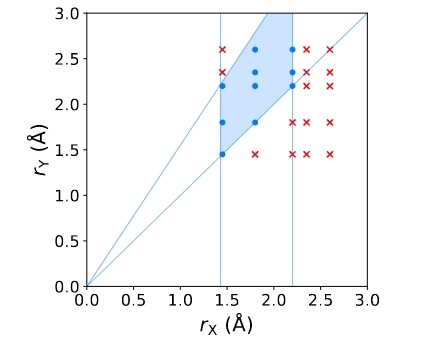Ab initio study of the crystal and electronic structure of mono- and bi-alkali antimonides: Stability, Goldschmidt-like tolerance factors, and optical properties
Mono- and bi-alkali antimonides, X2YSb (X and Y from Group I), are promising for next-generation electron emitters due to their capability of producing high-quality electron beams. How-ever, these materials are not yet well understood, in part due to the technical challenges in growing pure, ordered alkali antimonides. For example, in the current literature there is a lack of complete understanding of the mechanically stable crystal structures of these materials. As a first step towards understanding this issue, this paper presents an ab initio study of stability of single-crystal mono-and bi-alkali antimonides in the D03 structure, the structure generally assumed in the literature for these materials.
As a first step towards understanding this issue, this paper presents an ab initio study of stability of single-crystal mono-and bi-alkali antimonides in the D03 structure, the structure generally assumed in the literature for these materials. Finding that many of these materials actually are unstable in the D03 structure, we formulate a new set of Goldschmidt-like tolerance factors that accurately predict D03 stability using a procedure analogous to machine-learning perceptron-based analysis. Next, we consider possible stable structures for materials that we predict to be unstable in the D03 structure. Taking as examples the mono- and bi-alkali antimonides Cs3Sb and Cs2KSb, which also are technologically interesting for photoemission and photoabsorption applications, respectively, we note that the most unstable phonon displacements are consistent with the cubic structure, and we therefore perform extensive ab initio searches to identify potential ground-state structures in a cubic lattice. Our X-ray diffraction experiments confirm that indeed these two materials are not stable in the D03 structure and show scattering that is consistent with our new, proposed stable structures. Finally, we explore ab initio the implications of the breaking of the D03 symmetry on the electronic structure, showing significant impact on the location of the optical absorption edge
References:
J. K. Nangoi, M. Gaowei, A. Galdi, J. M. Maxson, S. Karkare, J. Smedley, and T. A. Arias, “Ab initio study of the crystal and electronic structure of mono- and bi-alkali antimonides: Stability, Goldschmidt-like tolerance factors, and optical properties.” arXiv, May 27, 2022 [Online]. Available: http://arxiv.org/abs/2205.14322.

